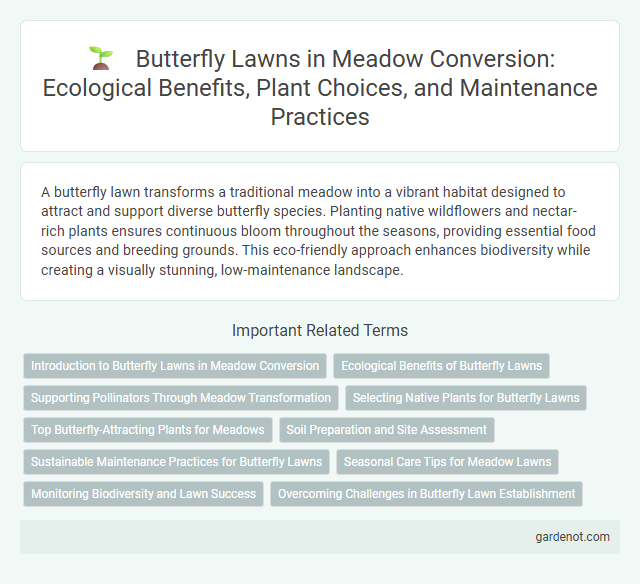A butterfly lawn transforms a traditional meadow into a vibrant habitat designed to attract and support diverse butterfly species. Planting native wildflowers and nectar-rich plants ensures continuous bloom throughout the seasons, providing essential food sources and breeding grounds. This eco-friendly approach enhances biodiversity while creating a visually stunning, low-maintenance landscape.
Introduction to Butterfly Lawns in Meadow Conversion
Butterfly lawns play a vital role in meadow conversion by providing essential habitats and nectar sources for various butterfly species. These specialized lawns are composed of native wildflowers and grasses that support butterfly lifecycles, enhancing biodiversity and promoting pollination. Implementing butterfly lawns in meadow conversion projects fosters healthier ecosystems and helps conserve declining butterfly populations.
Ecological Benefits of Butterfly Lawns
Butterfly lawns support biodiversity by providing essential nectar sources and habitat for native pollinators, including various butterfly species. These lawns enhance ecosystem services such as pollination, which benefits nearby plant life and agricultural crops. Incorporating native wildflowers and grasses in butterfly lawns promotes soil health and reduces the need for chemical fertilizers and pesticides.
Supporting Pollinators Through Meadow Transformation
Butterfly lawns, designed with native wildflowers and nectar-rich plants, create essential habitats that support pollinator populations by providing food and breeding grounds. Transforming traditional lawns into butterfly meadows enhances biodiversity, attracting key pollinators like monarchs, swallowtails, and painted ladies. This ecological shift strengthens local ecosystems by improving pollination services crucial for food crops and wild plant reproduction.
Selecting Native Plants for Butterfly Lawns
Selecting native plants for butterfly lawns is essential to support local butterfly species and promote biodiversity. Native host plants such as milkweed, violet, and goldenrod provide crucial nourishment for caterpillars, while nectar-rich flowers like coneflowers and asters attract adult butterflies. Prioritizing regional native species ensures higher survival rates and adapts well to local soil and climate conditions, enhancing the overall health of the butterfly lawn ecosystem.
Top Butterfly-Attracting Plants for Meadows
Butterfly lawns thrive with top butterfly-attracting plants such as milkweed, coneflowers, and black-eyed Susans, which provide essential nectar and breeding habitats. Native wildflowers like butterfly bush and verbena enhance pollinator diversity and support local ecosystems. Incorporating these plants into meadow conversions increases butterfly populations and promotes biodiversity.
Soil Preparation and Site Assessment
Soil preparation for butterfly lawn meadow conversion involves testing pH levels, ensuring soil fertility, and improving drainage to create an optimal habitat for native butterfly-friendly plants. Site assessment includes evaluating sunlight exposure, existing vegetation, and soil texture to select appropriate wildflower species that support local butterfly populations. Proper soil amendment and site evaluation significantly enhance plant establishment and biodiversity in butterfly lawn meadows.
Sustainable Maintenance Practices for Butterfly Lawns
Butterfly lawns thrive through sustainable maintenance practices such as reduced mowing frequency, allowing wildflowers to bloom fully and support pollinator habitats. Implementing organic weed control methods and avoiding synthetic pesticides enhances biodiversity and soil health. Incorporating native plant species ensures resilience against local pests and climate variations, promoting long-term ecological balance.
Seasonal Care Tips for Meadow Lawns
Butterfly lawns thrive with seasonal care that supports native pollinators and enhances biodiversity. In spring, mow lightly to remove winter debris and promote fresh growth, avoiding heavy cuts that disrupt butterfly habitats. Summer requires minimal watering and selective weeding to prevent invasive species from overtaking wildflowers, while autumn mowing after seed drop encourages healthy regrowth and prepares the meadow for winter dormancy.
Monitoring Biodiversity and Lawn Success
Butterfly lawns provide a vital habitat that supports diverse pollinator species, making continuous biodiversity monitoring essential to track population growth and ecosystem health. Regular assessments of native butterfly species abundance and plant diversity help evaluate lawn success and guide adaptive management practices. Employing tools such as species inventories and ecological surveys ensures effective conservation outcomes and sustained habitat quality.
Overcoming Challenges in Butterfly Lawn Establishment
Successfully establishing a butterfly lawn requires careful soil preparation to ensure optimal drainage and nutrient levels suited for native wildflowers such as milkweed and coneflower. Managing invasive species and maintaining a balanced mowing schedule promotes healthy growth and supports diverse butterfly populations like monarchs and swallowtails. Regular monitoring of pollinator activity and adaptive planting strategies help overcome environmental stressors and enhance habitat resilience.
Butterfly lawn Infographic

 gardenot.com
gardenot.com